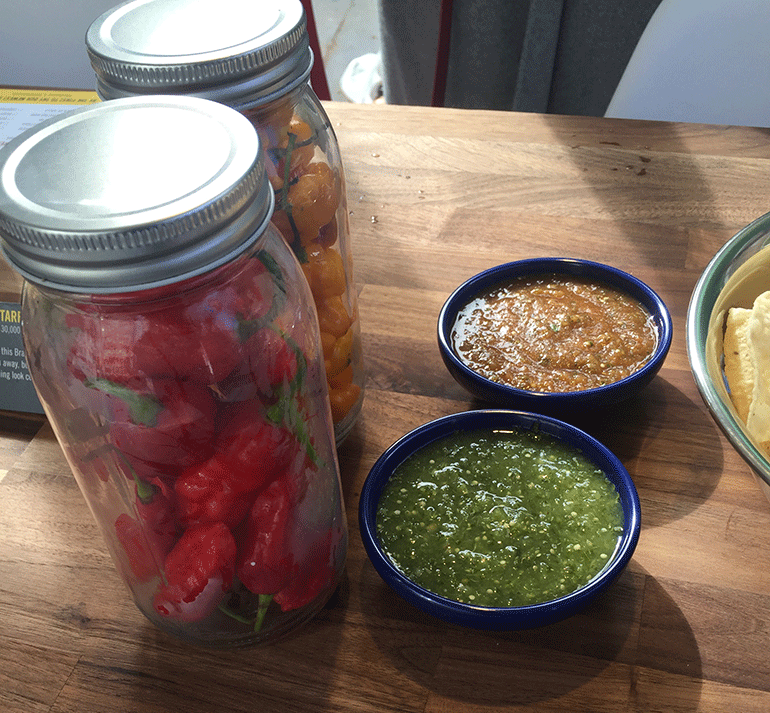Moe’s Southwest Grill commissioned a truck and drove it from Texas to New York City so they could feed burritos to me and some other members of the media.
Considering that there are three Moe’s locations within walking distance of my Midtown Manhattan office, I’m not sure they needed to have bothered, but they didn’t ask me how to spend their marketing dollars.
From here they’re driving the truck to three other markets where they have a strong presence — Atlanta, where they’re headquartered, as well as Tampa and Orlando.

It’s all part of their rebranding mission, which CEO Bruce Schroder was motivated by studies with their existing and lapsed customers that found that they weren’t getting credit for the “freshness, variety and quality, which we spend an awful lot of time and money trying to deliver.”
He said the Focus Brands subsidiary’s 700 some-odd locations make a total of 40,000 pounds of salsa in-house every day, and use 30,000 pounds of tomatoes, 10,000 pounds of onions and 5,000 pounds each of jalapeños and cilantro.
 So Moe’s is rebranding with new in-store elements that will highlight its made-from-scratch bona fides.
So Moe’s is rebranding with new in-store elements that will highlight its made-from-scratch bona fides.
Schroder didn’t go into detail as to what exactly that will mean, and at any rate that kind of remodeling takes a while, hence the truck, to bring those new flavors to us.
Those new flavors include Adobo Chicken, made from thigh meat instead of breast, which will replace the existing chicken, and spicier salsas.
17-year-old Moe’s has long had rotating seasonal salsas, but they’ll now be using spicier peppers in some of them. For example, they’ll be using ghost peppers in their new Ghostujang, which we tried in the truck. The name’s a play on the trendy Korean chile paste gochujang, which it doesn’t taste like at all, but it is a reasonably spicy salsa.
Also appearing in restaurants soon will be a seasonal Ahhhvocado salsa, which is sort of like a thin, high-citrus guacamole.
Schroder also said they were working on emphasizing the “Southwest” in their name with new items.
“You’re very familiar with what Popeyes did, right?” he asked me. “They were in a sea of chicken sameness and they seized on Louisiana and used it as a differentiator.”
He said “Southwest” isn’t completely defined as a cuisine so Moe’s has a chance to define it. He didn’t go into detail as what that might be. They already have queso, which is an important component of Tex-Mex food, which is arguably an important component in Southwestern cuisine. In fact, Schroder said they got a significant boost in queso sales when an unnamed competitor recently added queso to its offerings (I’m going to go ahead and say it was Chipotle Mexican Grill, even if Schroder didn’t).

Schroder did say the chain was going to go beyond burritos. Considering that they already have quesadillas and tacos and nachos on their menu, I’m not sure what that might be. Pozole maybe? That’s a Mexican corn soup that’s popular in New Mexico. Chiles rellenos are big in the Southwest, that would be cool.
Tamales, maybe?
Wienerschnitzel just introduced tamales for the holidays (they’re a Christmas tradition in Mexico), and TacoTime is rolling out a tamale burrito stuffed with seasoned ground beef, cheese sauce, sour cream and tamale bites filled with jalapeño and cheese.
If Moe’s jumps on that we’ll have a nice little trend. But time will tell.
Schroder also said they were working on a number of “chef creations,” menu items not meant to be infinitely customized but designed to be delicious as-is. That eliminates the risk of customers selecting ingredients that don’t actually taste good when mixed together in a burrito or bowl or quesadilla. It also ought to speed up service.
Additionally, it allows chefs to use more distinctive ingredients that taste great in certain combinations but don’t play well with all other ingredients. That would open the way for more experimentation with funky, maybe fermented flavors that have growing but still niche appel.
Schroder said they’re planning on making those items on the second line that’s being installed in many Moe’s locations and is currently being used for delivery and catering.
That’s part of an ongoing trend of fast-casual restaurants moving away from the model of pure customization.
Formerly all-customizable chain Piada recently made a strong turn away from that approach with its latest menu revamp at its 37 locations, and smaller chains such as 10-unit Asian Box has seen success with its new “curated” menu items.
Although the create-your-own model still clearly has appeal to many consumers, I think it’s refreshing that some customers are comfortable putting themselves in the capable hands of chefs, even at limited-service restaurants.
Contact Bret Thorn at [email protected]
Follow him on Twitter: @foodwriterdiary

